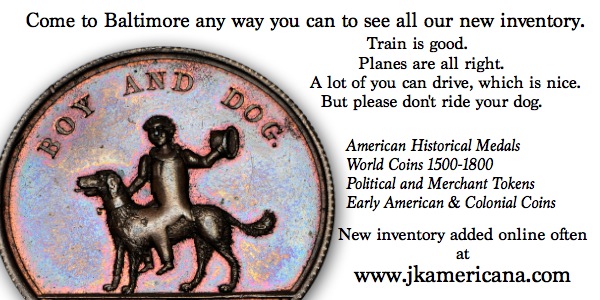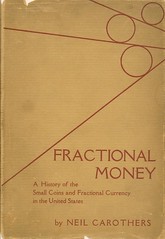
PREV ARTICLE
NEXT ARTICLE
FULL ISSUE
PREV FULL ISSUE
BOOK REVIEW: FRACTIONAL MONEY BY CAROTHERS
David Ginsburg submitted this review of a classic book on U.S. numismatics. Thanks!
-Editor
Since you invited us to submit reviews of older books. . . Today I write of the foundational text of American numismatic researchers, the book that should need no introduction. . . In 1997 I was still fairly new to coin collecting and hadn't really bought more than one or two numismatic books. I was familiar with Q. David Bowers, because a friend of mine had given me his majestic silver dollar encyclopedia (a gift less expensive than you might think, I hasten to add, because it was purchased at what-turned-out-to-be the much-discounted initial price offered in Coin World). After reading the encyclopedia, I began to ask some of the questions that started me on the road to becoming a numismatic researcher. I didn't want to look at coins through a microscope, I wanted to know "why" - why were so many Morgan dollars minted when silver dollars had never been popular? ... that sort of thing. Knowing that Mr. Bowers was an established numismatic researcher, I attended the 1997 ANA Convention in New York determined to speak with him about what I should do to conduct numismatic research. I was determined to ask coherent, intelligent, questions. Well, of course, when my opportunity came, Mr. Bowers was in the midst of a number of activities and I was pretty tongue-tied. Gazing sympathetically at me after I finally choked out something mildly incoherent, he said: "Well, you should really start by reading Fractional Money by Neil Carothers."
Of course, as you might expect of a PhD thesis, the book is heavily footnoted and Mr. Carothers provides an extensive bibliography. Well! In my eyes, these are the best features of the book! If you want to learn what monetary economists thought in the 19th century, you need only to plunder the bibliography to find everything from William Gouge's Short History of Paper-Money and Banking (1835) to John Jay Knox's United States Notes (1885) to A. Barton Hepburn's History of Currency in the United States (1924). If you didn't know that Hunt's Merchants Magazine, Bankers Magazine and Niles' Weekly Register existed, you would learn of them here. If you didn't know that the Mint published annual reports that provided more than mintage numbers or that the Secretary of the Treasury also published annual reports that touched on a variety of topics, you would learn that here. Needless to say, the whole world of primary source material opened to me once I took Mr. Bowers' advice. What more can I say about a book that opened a whole world to me? The book is available in two hardcover editions and, apparently, two paperback editions. The original 1930 hardcover edition by John Wiley & Sons seems to be the hardest to find. In 1967, Augustus M. Kelley reprinted the book in hard cover as part of its Reprints of Economic Classics series. In 1988, of course, Bowers and Merena produced the facsimile paperback edition that we see most often and in 2007, apparently, Kessinger Publishing released a paperback edition, as well. Copies of the book are available through Bookfinder.com as well as from numismatic booksellers and through numismatic book auctions. I, of course, still have the Bowers and Merena paperback I acquired in 1997 and, I'm pleased to say, I just acquired a copy of the Kelley hardcover - my paperback copy having been read a number of times, I don't want to wear it out!
The Carothers book is one of my favorite books on U.S. numismatics, for all of the same reasons. If you're interested in U.S. coinage and don't have a copy, run out and get one now, even if it's only the reprint. Even harder to find than the original 1930 edition is one with an intact dust jacket, pictured above. It took me years to locate one.
-Editor

Wayne Homren, Editor The Numismatic Bibliomania Society is a non-profit organization promoting numismatic literature. See our web site at coinbooks.org. To submit items for publication in The E-Sylum, write to the Editor at this address: whomren@gmail.com To subscribe go to: https://my.binhost.com/lists/listinfo/esylum All Rights Reserved. NBS Home Page Contact the NBS webmaster 
|
